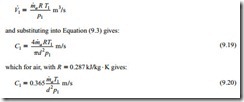The influence of altitude
As elevation increases, pressure naturally decreases, and so the elevation of a plant above sea level should always be noted for reference. With increase in elevation there is a corresponding drop in the value of the local atmospheric pressure and this will influence many of the velocities and volumetric flow rates in the calculations. There is, of course, a direct influence on the performance of vacuum conveying systems, since any reduction in atmospheric pressure automatically reduces the maximum available pressure difference. The variation of the local value of atmospheric pressure with the elevation of a plant above sea level is presented in Figure 9.21.
Atmospheric pressure
It will be seen from Figure 9.21 that for a plant located 1000 m above sea level there is a reduction of more than 10 per cent in atmospheric pressure, and equates to a reduction in pressure of about 11.4 kN/m2 or 3.4 in Hg.
It will be seen from this that the influence of altitude should be considered in detail for plants located above about 300 m, particularly if a vacuum conveying system is to be considered. The normal atmospheric pressure at sea level can fluctuate quite naturally
by ±1 in. (25 mm) Hg on a day to day basis, which equates to a change in elevation of about 300 m. This fact might also have to be taken into account with vacuum systems operating on tight margins.
The use of air mass flow rate
When presenting data on the relationship between the main conveying parameters for a material in a given pipeline, air mass flow rate is generally used in preference to volumetric flow rate. Ideally air velocity should be used, as it is such an important parameter in pneumatic conveying. Due to the problems of compressibility, however, neither conveying line inlet air velocity nor volumetric flow rate are ideal for this purpose as they are not independent parameters. Air mass flow rate is an independent variable and is an ideal substitute in this work as its value remains constant along the length of a pipeline, whether single bore or stepped. Conveying air velocity and volumetric flow rate can be determined quite simply from air mass flow rate as follows:


